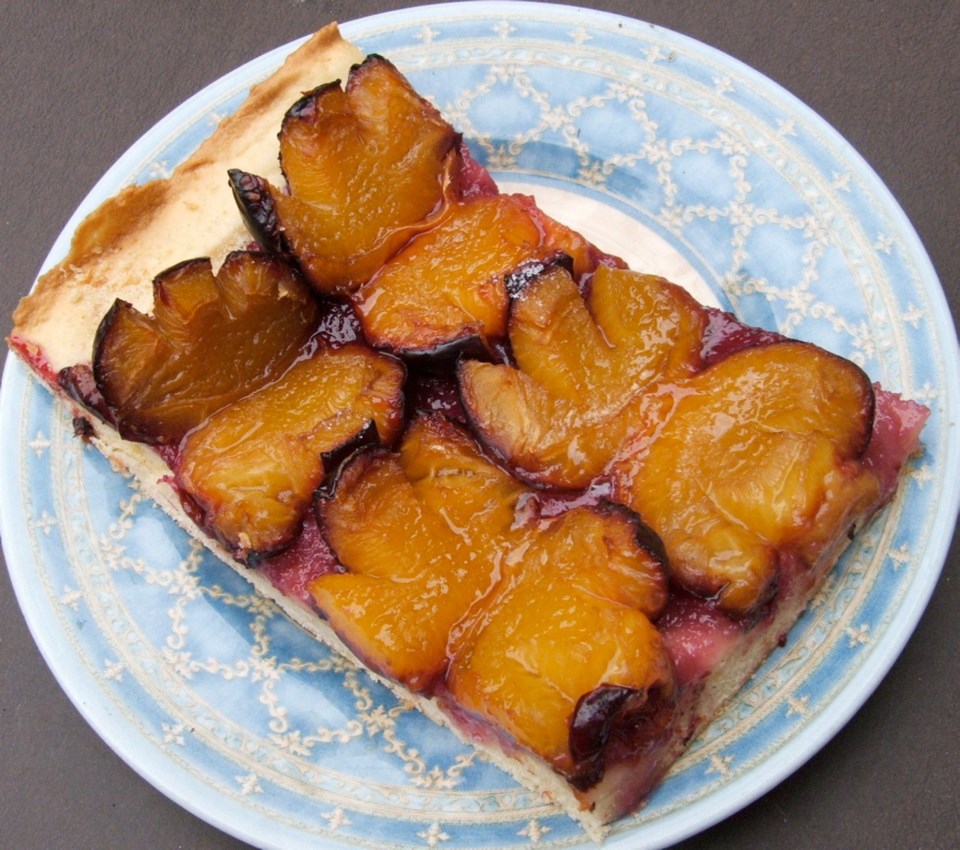Dear Helen: A neighbour has told me about a recipe for an easy plum cake that you wrote about a few years ago. She remembers it as simply halved plums baked on a crust. Do you still have that recipe?
P.L.
I bring out this recipe every summer as the prune plums ripen. It’s a super-simplified version of one from a neighbour. It can be made year-round, using frozen prune plum halves.
Crust
1/2 cup butter (soft, not melted)
1 cup flour
1-2 Tbsp icing sugar
Combine and spread onto oiled parchment paper in a 9 x 13 pan.
Place halved plums, skin side down, on the crust. Make small cuts around their edges to keep them lying flat. I find that the space uses 20 plums — five halves across and eight down the long side. Bake at 350 F for about 45 minutes. Let cool a bit, then sprinkle with a little sugar.
Dear Helen: Three of my tomato plants, all different varieties, are planted in large pots. Some of the tomatoes on the Early Girl plant had discolourations on their lower ends.
Can you identify the problem? All the pots were watered the same amount and at the same times. Tomato plants in the open garden are fine.
M.V.
Dark or tan, slightly sunken areas at the far (blossom) ends of tomatoes indicate blossom end rot, a very common issue in this long, hot, dry summer. The discolouration is caused by a calcium deficiency in the fruit tissue.
That does not necessarily mean, however, that the soil is deficient in calcium. More often, the cause is irregular moisture levels in the soil. Because calcium moves into plants along with water, the mineral will be deficient in plants growing in dry soil.
Another factor that sometimes comes into play is an excess of nitrogen in the soil, causing growth that is too fast for calcium to keep up with as it moves through the plant and into the fruit.
As soil and air temperatures warm in late spring and early summer, a generous, nourishing mulch laid under and around the plants after a deep watering helps to maintain soil moisture.
Because plants growing in pots are more difficult to keep adequately and consistently watered in hot weather than ones in the open garden, potted tomatoes are more susceptible to developing blossom end rot. Susceptibility also differs among varieties. That’s likely why just one of your varieties had tomatoes with the condition.
Dear Helen: Many of my plants suffered in the heat this summer, even the tomatoes. Someone told me to shade them with floating row covers, but that didn’t seem to help. I’m wondering how to manage this issue next summer, which will likely be another hot one.
H.T.
Lightweight, floating row covers such as Remay, which are secured over plantings like carrots, beets and onions to protect them from insect pests, are not recommended for shading and cooling plants. In fact, they do the opposite. They trap heat.
Tomatoes growing on supports such as wire fencing or tall stakes, and those growing in tomato cages, are fairly easy to cool down with a bit of shade during periods of intense heat.
Horticultural shade cloth, used to shade greenhouses in summer, is a good choice. Alternatives are old, lightweight sheets or curtains suspended over the plants during the hottest part of the day, from noon to around 4 p.m.
Garden Events
Floral arts. The Mid Island Floral Art Club will meet on Thursday, Sept. 13, at 2 p.m. in St. Stephen’s Church Hall, 150 Village Way in Qualicum Beach. The meeting will feature a special demonstration by Lilo and Stephane from Fresh ‘n Fabulous. Cost of admission for guests is $10.
Plant sale. The Peninsula Garden Club will host a Fall Plant Sale on Saturday, Sept. 15, from 9 to 11 a.m. in the Mary Winspear Centre in Sidney.
Mixing it up conference. Registration is open now for Victoria Master Gardener Association’s Beauty & the Beast conference on Feb. 2, 2019, with Dr. Glynn Percival, U.K. – Those Lurking Beneath; Janis Matson, Vancouver – Mood: Colour, Light and Sound; Claudia Copley, Victoria – The Good, the Bad and the Merely Ugly; Paul Hervey-Brookes, U.K. – Plants: RHS Award of Garden Merit. Information and registration at mixingitup.org. Last day for early bird price is Oct. 14. This event sells out early.



